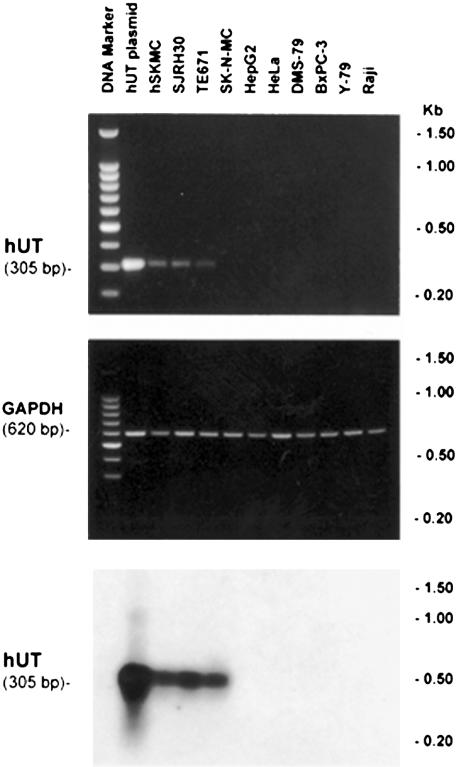Figure 3.
Expression of hUT mRNA is specific to skeletal muscle cells and is not evident in cell lines that are of ‘non-striated muscle' origin. Upper panel: RT–PCR samples were size-fractionated in an ethidium bromide-stained 2% agarose gel (100 bp DNA ladder is shown in lane 1). Amplification of a specific hUT amplicon (305 bp) was detected using cDNAs generated from hUT plasmid (lane 2) and the human skeletal muscle cell lines hSKMC (primary cell line; lane 3), SJRH30 and TE671 (rhabdomyosarcoma cell lines; lanes 4 and 5, respectively). No amplicon was found in a variety of ‘non-skeletal muscle' human cell lines, namely SK-N-MC (supra-orbital neuroblastoma), HepG2 (hepatoblastoma), HeLa (cervical adenocarcinoma), DMS-79 (small cell lung carcinoma), BxPC-3 (pancreatic adenocarcinoma), Y-79 (retinoblastoma) and Raji B-lymphocyte (Burkitt's lymphoma) cells (lanes 6–12, respectively). Middle panel: amplification of GAPDH cDNA (620 bp amplicon) was evident in all samples studied. Lower panel: the presence of hUT gene was confirmed in human skeletal muscle cell lines hSKMC, SJRH30 and TE671 cells by Southern blot analysis (PCR products were tranferred to a nylon membrane and probed with full-length hUT cDNA to generate a 305 bp hybridization product). Data shown one from a single determination.

